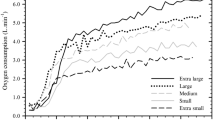Summary
This paper examines how selected physiological performance variables, such as maximal oxygen uptake, strength and power, might best be scaled for subject differences in body size. The apparent dilemma between using either ratio standards or a linear adjustment method to scale was investigated by considering how maximal oxygen uptake (1·min−1), peak and mean power output (W) might best be adjusted for differences in body mass (kg). A curvilinear power function model was shown to be theoretically, physiologically and empirically superior to the linear models. Based on the fitted power functions, the best method of scaling maximum oxygen uptake, peak and mean power output, required these variables to be divided by body mass, recorded in the units kg2/3. Hence, the power function ratio standards (ml·kg−2/3·min−1) and (W·kg−2/3) were best able to describe a wide range of subjects in terms of their physiological capacity, i.e. their ability to utilise oxygen or record power maximally, independent of body size. The simple ratio standards (ml·kg−1·min−1) and (W·kg−1) were found to best describe the same subjects according to their performance capacities or ability to run which are highly dependent on body size. The appropriate model to explain the experimental design effects on such ratio standards was shown to be log-normal rather than normal. Simply by taking logarithms of the power function ratio standard, identical solutions for the design effects are obtained using either ANOVA or, by taking the unscaled physiological variable as the dependent variable and the body size variable as the covariate, ANCOVA methods.
Similar content being viewed by others
References
Astrand P-O, Rodahl K (1986) Textbook of work physiology, 3rd edn. McGraw-Hill, New York
Baker RJ, Nelder JA (1978) Generalized linear interactive modelling, release 3. Numerical Algorithms Group, Oxford
Holmyard DJ, Chia YHM, Lakomy HKA, Nevill ME (1991) Effects of training on treadmill sprinting and recovery. J Sports Sci 9: 417–418
Katch VL (1972) Correlation v ratio adjustment of body weight in exercise-oxygen studies. Ergonomics 15: 671–680
Katch VL (1973) Use of the oxygen/body weight ratio in correlational analyses: spurious correlations and statistical considerations. Med Sci Sports Exerc 5: 253–257
Katch VL, Katch FI (1974) Use of weight-adjusted oxygen uptake scores that avoid spurious correlations. Res Q 4: 447–451
Kleiber M (1950) Physiological meaning of regression equations. J Appl Physiol 2: 417–423
McMahon TA (1984) Muscles, reflexes and locomotion. Princeton University Press, New Jersey
Minitab Reference Manual (1989) Minitab Inc. 3081, Enterprise Drive, State Collage, PA 16801, USA
Nevill AM, Ramsbottom R, Williams C (1990) The relationship between athletic performance and maximal oxygen uptake. J Sports Sci 8: 290–292
Nevill AM, Ramsbottom R, Williams C, Winter EM (1991) Scaling physiological performance measurements for individuals of different body size. J Sports Sci 9: 427–428
Ribisl PM, Kachadorian WA (1969) Maximal oxygen intake prediction in young and middle aged males. J Sports Med Phys Fitness 9: 17–22
Schmidt-Nielsen K (1984) Scaling: why is animal size so important? Cambridge University Press, Cambridge
Secher N (1990) Rowing. In: Reilly T, Sencher N, Snell P, Williams CE, Spoon FN (eds) Physiology of sports. Chapman and Hall, London, pp 259–286
Secher N, Vaage O, Jensen K, Jackson RC (1983) Maximal aerobic power in oarsmen. Eur J Appl Physiol 51: 155–162
Tanner JM (1949) Fallacy of per-weight and per-surface area standards and their relation to spurious correlations. J Appl Physiol 2: l-15
Taylor HL, Buskirk E, Henschel A (1955) Maximum oxygen intake as an objective measure of cardiorespiratory performance. J Appl Physiol 8: 73–80
Williams C, Nute MLG (1983) Some physiological demands of a half-marathon race on recreational runners. Br J Sports Med 17: 152–161
Winer BJ (1971) Statistical principles in experimental design. McGraw-Hill, New York
Winter EM, Brookes FBC, Hamley EJ (1991) Maximal exercise performance and lean leg volume in men and women. J Sports Sci 9: 3–13
Author information
Authors and Affiliations
Rights and permissions
About this article
Cite this article
Nevill, A.M., Ramsbottom, R. & Williams, C. Scaling physiological measurements for individuals of different body size. Europ. J. Appl. Physiol. 65, 110–117 (1992). https://doi.org/10.1007/BF00705066
Accepted:
Issue Date:
DOI: https://doi.org/10.1007/BF00705066




